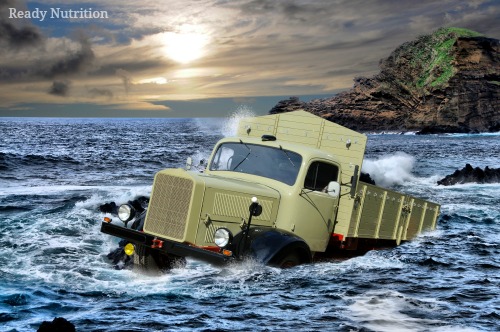This article was originally published by Tess Pennington at Ready Nutrition
Tess is the author of The Prepper’s Blueprint: How To Survive ANY Disaster.

According to studies, over 10,000 water immersion auto accidents occur each year and over 300 people on average, perish before getting out. How many of you know what to do? Do you wait until the car has filled up with water so the car is pressurized and you can escape more easily? This is a common answer, but could get you killed. Many die because they have received the wrong information on how to escape a sinking vehicle. Breathing from a bubble of trapped air, kicking out a window or waiting until the car touched bottom all yields a less than 10 percent survival rate.
Here are the Facts:
Stay Calm: When an emergency arises and no plan is in place, things get tricky pretty fast. Stress or anxiety, especially after an unexpected event, leads to a short term imbalance of neurotransmitters, such as serotonin and norepinephrine, and inevitably leads to physical and emotional reactions to stress such as disorientation, increased breathing, panic and heart palpitations. Knowing how to curb these natural reactions can reduce the emotional and physical reactions.
Have a Plan: In a one minute period, a car will completely fill with water. Having a plan in place is the best way to improve your chances of survival and those with you. If the water is filling the car, quickly talk to your occupants and let them know what needs to happen. It is paramount that you keep as calm as possible because you have very little time to act. Survival Systems USA, has found that it takes about 20 seconds to escape through the door of a submerged car. A calm, relaxed person can hold their breath for 30 to 45 seconds underwater. So, if your pulse is pounding, you don’t have much room for error.
Make Your Escape: In many cases, a vehicle will actually float on top of the water for 30-120 seconds before sinking. Use this time to first undo your own seat belt and then, undo older children first so that they can help you with others or at least help themselves to safety. Once seat belts have been undone or cut, open the driver-side window and escape, first pushing children out ahead of you.
Do not wait until the car has completely filled with water. As well, do not open the door and try to escape. While you might be able to get out, the car will quickly fill with water and sink more rapidly, possibly trapping your passengers. Breaking a window is your best bet in making a quick exit. Because the windows are made of strong, tempered glass, it is important to have an accessible tool, like car safety hammer or the Tactical Auto Rescue tool, to easily cut through seat belt materials and break the window. If you have no tools or heavy objects to break the window with, use your feet.
Don’t waste precious seconds calling for help. Wait until you are safely out of the water before attempting to call 911.
In the following video, Dr. Gordon Giesbrecht, who specializes in cold water immersion has tested controlled sinking scenarios in vehicles using different strategies. “Bottom line, you have to remember four words, “Giesbrecht said. “Seatbelts. Windows. Children. Out.”
***
(Sign up for our FREE newsletter to get the latest prepping advice, gardening secrets, homesteading tips and more delivered straight to your inbox!)
Additional Resources:
The Prepper’s Blueprint: The Step-By-Step Guide To Help You Through Any Disaster
Prepper’s Home Defense: Security Strategies to Protect Your Family by Any Means Necessary
The Survival Medicine Handbook: A Guide for When Help is Not on the Way
SAS Survival Handbook, Revised Edition: For Any Climate, in Any Situation
Tess Pennington is the author of The Prepper’s Blueprint, a comprehensive guide that uses real-life scenarios to help you prepare for any disaster. Because a crisis rarely stops with a triggering event the aftermath can spiral, having the capacity to cripple our normal ways of life. The well-rounded, multi-layered approach outlined in the Blueprint helps you make sense of a wide array of preparedness concepts through easily digestible action items and supply lists.
Tess is also the author of the highly rated Prepper’s Cookbook, which helps you to create a plan for stocking, organizing and maintaining a proper emergency food supply and includes over 300 recipes for nutritious, delicious, life-saving meals.
Visit her web site at ReadyNutrition.com for an extensive compilation of free information on preparedness, homesteading, and healthy living.










0 Comments